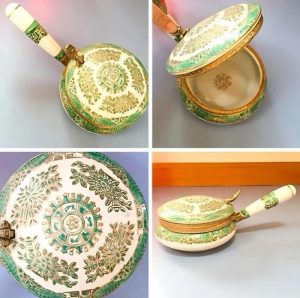When my parents purchased a new house, they never expected to inherit a small mystery along with it. Moving into a home always comes with surprises—sometimes it’s an old, forgotten attic full of relics from previous owners, or a peculiar design choice left behind by those who lived there before. But in our case, it was a strange little object, something neither of us had ever seen before, perched on a shelf in the corner of the living room.
At first glance, the object seemed unremarkable, yet oddly out of place. It was small, resembling a cross between a miniature frying pan and an antique box. The more we looked at it, the more intriguing it became. It had an ornate design, with golden patterns swirling across its surface, and delicate green embellishments giving it an almost regal touch. The craftsmanship was intricate, which suggested that it wasn’t just an ordinary trinket. However, none of us had any idea what it was or what it was used for.

Curious but not particularly concerned, we decided to leave it where it was. Maybe it was a decorative keepsake left behind intentionally, or perhaps the previous owners simply forgot to pack it up. Either way, it became part of the house’s charm, blending into the living room decor. We occasionally joked about it, tossing around wild guesses about its purpose, but for a while, it remained just another piece of decor, an unsolved mystery that no one took too seriously.
That changed one evening when our neighbor, Victor, paid us a visit. Victor was a well-known history buff, particularly fascinated by antiques and objects from bygone eras. If anyone could solve the mystery of this peculiar item, it would be him. The moment he spotted it, his eyes lit up with amusement, and a knowing smile spread across his face.
“You have no idea what this is, do you?” he asked, chuckling as he picked up the object and examined it closely.
We all shook our heads, eager for an answer. He turned it over in his hands, admiring the craftsmanship, before finally revealing the truth.
“This, my friends, is an old-fashioned crumb collector,” he announced, his voice carrying a touch of nostalgia. “Back in the day, people used these to sweep away crumbs, ashes, and small bits of food from the dining table. It was part of a proper table-setting in wealthy households. Before dishwashers and modern table manners, people had tools like this to keep things tidy.”
The idea fascinated us. We imagined a time when dinner tables were grand affairs, where servants or hosts would use this elegant little pan to discreetly sweep away debris. The thought of such an object being a staple in aristocratic homes made it even more interesting.
Victor continued, pointing out details we hadn’t noticed before. “Look at the fine details—gold accents, delicate engravings, and the sturdy handle designed for easy use. This wasn’t just any crumb collector; this was something meant for a wealthy household, possibly part of an elaborate dining set.”
Hearing his explanation, we realized we had unknowingly stumbled upon a small relic from a time when elegance and practicality merged in ways we rarely see today. It was humbling to think about how something as simple as keeping a table clean once had a dedicated tool crafted with such precision and beauty.
It also made us appreciate how much daily life has changed. Today, we simply wipe down tables with a paper towel or brush crumbs into our hands without a second thought. But in the past, maintaining cleanliness, even during meals, was a refined and almost ceremonial act. The crumb collector wasn’t just a functional tool; it was a statement of status, a glimpse into the sophistication of a different era.
After Victor’s revelation, the object took on new meaning for us. It was no longer just an unidentifiable antique left behind by the previous owners—it was a piece of history, a conversation starter, a tangible connection to a past way of life. We could almost picture an elegant dinner party, candlelit and lively, with guests in fine attire enjoying a meal, while a discreet hand swept crumbs into this delicate little pan to maintain the table’s pristine appearance.
From that day forward, we looked at the crumb collector differently. Instead of being an overlooked relic, it became a prized piece in our home, displayed prominently as a reminder of history’s small but fascinating details. It even became a topic of discussion when guests visited—many of whom, like us, had never seen such an item before.
Interestingly, Victor also mentioned that such objects, while no longer used for their original purpose, have found a second life as decorative elements in vintage-style homes. Some collectors seek them out for their charm, while interior designers use them to add an antique touch to modern spaces. What was once a functional household item has now become a sought-after piece of decor, appreciated for its craftsmanship rather than its utility.
The more we learned about the crumb collector, the more we appreciated its history. It made us wonder what other treasures might be hidden in old homes, waiting to be rediscovered and appreciated anew. It also served as a reminder that sometimes, the smallest and seemingly insignificant things can have the most interesting stories behind them.
In the end, my parents’ new house not only gave them a fresh start but also gifted them a connection to the past—wrapped up in a tiny, ornate, and once-practical relic that had quietly waited on a shelf for someone to uncover its story.





